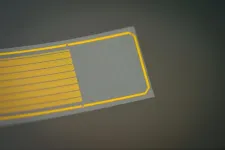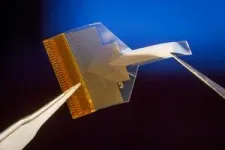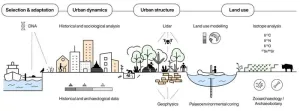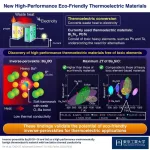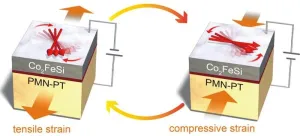(Press-News.org) Researchers at the University of California San Diego have developed a neural implant that provides information about activity deep inside the brain while sitting on its surface. The implant is made up of a thin, transparent and flexible polymer strip that is packed with a dense array of graphene electrodes. The technology, tested in transgenic mice, brings the researchers a step closer to building a minimally invasive brain-computer interface (BCI) that provides high-resolution data about deep neural activity by using recordings from the brain surface.
The work was published on Jan. 11 in Nature Nanotechnology.
“We are expanding the spatial reach of neural recordings with this technology,” said study senior author Duygu Kuzum, a professor in the Department of Electrical and Computer Engineering at the UC San Diego Jacobs School of Engineering. “Even though our implant resides on the brain’s surface, its design goes beyond the limits of physical sensing in that it can infer neural activity from deeper layers.”
This work overcomes the limitations of current neural implant technologies. Existing surface arrays, for example, are minimally invasive, but they lack the ability to capture information beyond the brain’s outer layers. In contrast, electrode arrays with thin needles that penetrate the brain are capable of probing deeper layers, but they often lead to inflammation and scarring, compromising signal quality over time.
The new neural implant developed at UC San Diego offers the best of both worlds.
The implant is a thin, transparent and flexible polymer strip that conforms to the brain’s surface. The strip is embedded with a high-density array of tiny, circular graphene electrodes, each measuring 20 micrometers in diameter. Each electrode is connected by a micrometers-thin graphene wire to a circuit board.
In tests on transgenic mice, the implant enabled the researchers to capture high-resolution information about two types of neural activity–electrical activity and calcium activity–at the same time. When placed on the surface of the brain, the implant recorded electrical signals from neurons in the outer layers. At the same time, the researchers used a two-photon microscope to shine laser light through the implant to image calcium spikes from neurons located as deep as 250 micrometers below the surface. The researchers found a correlation between surface electrical signals and calcium spikes in deeper layers. This correlation enabled the researchers to use surface electrical signals to train neural networks to predict calcium activity—not only for large populations of neurons, but also individual neurons—at various depths.
“The neural network model is trained to learn the relationship between the surface electrical recordings and the calcium ion activity of the neurons at depth,” said Kuzum. “Once it learns that relationship, we can use the model to predict the depth activity from the surface.”
An advantage of being able to predict calcium activity from electrical signals is that it overcomes the limitations of imaging experiments. When imaging calcium spikes, the subject’s head must be fixed under a microscope. Also, these experiments can only last for an hour or two at a time.
“Since electrical recordings do not have these limitations, our technology makes it possible to conduct longer duration experiments in which the subject is free to move around and perform complex behavioral tasks,” said study co-first author Mehrdad Ramezani, an electrical and computer engineering Ph.D. student in Kuzum’s lab. “This can provide a more comprehensive understanding of neural activity in dynamic, real-world scenarios.”
Designing and fabricating the neural implant
The technology owes its success to several innovative design features: transparency and high electrode density combined with machine learning methods.
“This new generation of transparent graphene electrodes embedded at high density enables us to sample neural activity with higher spatial resolution,” said Kuzum. “As a result, the quality of signals improves significantly. What makes this technology even more remarkable is the integration of machine learning methods, which make it possible to predict deep neural activity from surface signals.”
This study was a collaborative effort among multiple research groups at UC San Diego. The team, led by Kuzum, one of the world leaders in developing multimodal neural interfaces, includes nanoengineering professor Ertugrul Cubukcu, who specializes in advanced micro- and nanofabrication techniques for graphene materials; electrical and computer engineering professor Vikash Gilja, whose lab integrates domain-specific knowledge from the fields of basic neuroscience, signal processing, and machine learning to decode neural signals; and neurobiology and neurosciences professor Takaki Komiyama, whose lab focuses on investigating neural circuit mechanisms that underlie flexible behaviors.
Transparency is one of the key features of this neural implant. Traditional implants use opaque metal materials for their electrodes and wires, which block the view of neurons beneath the electrodes during imaging experiments. In contrast, an implant made using graphene is transparent, which provides a completely clear field of view for a microscope during imaging experiments.
“Seamless integration of recording electrical signals and optical imaging of the neural activity at the same time is only possible with this technology,” said Kuzum. “Being able to conduct both experiments at the same time gives us more relevant data because we can see how the imaging experiments are time-coupled to the electrical recordings.”
To make the implant completely transparent, the researchers used super thin, long graphene wires instead of traditional metal wires to connect the electrodes to the circuit board. However, fabricating a single layer of graphene as a thin, long wire is challenging because any defect will render the wire nonfunctional, explained Ramezani. “There may be a gap in the graphene wire that prevents the electrical signal from flowing through, so you basically end up with a broken wire.”
The researchers addressed this issue using a clever technique. Instead of fabricating the wires as a single layer of graphene, they fabricated them as a double layer doped with nitric acid in the middle. “By having two layers of graphene on top of one another, there’s a good chance that defects in one layer will be masked by the other layer, ensuring the creation of fully functional, thin and long graphene wires with improved conductivity,” said Ramezani.
According to the researchers, this study demonstrates the most densely packed transparent electrode array on a surface-sitting neural implant to date. Achieving high density required fabricating extremely small graphene electrodes. This presented a considerable challenge, as shrinking graphene electrodes in size increases their impedance—this hinders the flow of electrical current needed for recording neural activity. To overcome this obstacle, the researchers used a microfabrication technique developed by Kuzum’s lab that involves depositing platinum nanoparticles onto the graphene electrodes. This approach significantly improved electron flow through the electrodes while keeping them tiny and transparent.
Next steps
The team will next focus on testing the technology in different animal models, with the ultimate goal of human translation in the future.
Kuzum’s research group is also dedicated to using the technology to advance fundamental neuroscience research. In that spirit, they are sharing the technology with labs across the U.S. and Europe, contributing to diverse studies ranging from understanding how vascular activity is coupled to electrical activity in the brain to investigating how place cells in the brain are so efficient at creating spatial memory. To make this technology more widely available, Kuzum’s team has applied for a National Institutes of Health (NIH) grant to fund efforts in scaling up production and facilitating its adoption by researchers worldwide.
“This technology can be used for so many different fundamental neuroscience investigations, and we are eager to do our part to accelerate progress in better understanding the human brain,” said Kuzum.
Paper title: “High-density Transparent Graphene Arrays for Predicting Cellular Calcium Activity at Depth from Surface Potential Recordings.” Co-authors include Jeong-Hoon Kim*, Xin Liu, Chi Ren, Abdullah Alothman, Chawina De-Eknamkul and Madison N. Wilson, all at UC San Diego.
*Study co-first author
This research was supported by the Office of Naval Research (N000142012405, N000142312163 and N000141912545), the National Science Foundation (ECCS-2024776, ECCS-1752241 and ECCS-1734940) and the National Institutes of Health (R21 EY029466, R21 EB026180, DP2 EB030992, R01 NS091010A, R01 EY025349, R01 DC014690, R21 NS109722 AND P30 EY022589), Pew Charitable Trusts, and David and Lucile Packard Foundation. This work was performed in part at the San Diego Nanotechnology Infrastructure (SDNI) at UC San Diego, a member of the National Nanotechnology Coordinated Infrastructure, which is supported by the National Science Foundation (grant ECCS-1542148).
END
Transparent brain implant can read deep neural activity from the surface
2024-01-11
ELSE PRESS RELEASES FROM THIS DATE:
Ancient cities provide key datasets for urban planning, policy and predictions in the Anthropocene
2024-01-11
Cities play a key role in climate change and biodiversity and are one of the most recognizable features of the Anthropocene. They also accelerate innovation and shape social networks, while perpetuating and intensifying inequalities. Today over half of all humanity lives in cities, a threshold which will rise to nearly 70% by the mid-21st century. Yet despite their importance for the Anthropocene, cities are not a recent phenomenon.
In a new study, an interdisciplinary team of authors from the Max Planck Institute of Geoanthropology ...
First prehistoric person with Turner syndrome identified from ancient DNA
2024-01-11
Francis Crick Institute press release
Under strict embargo: 10:00hrs GMT 11 January 2024
Peer reviewed
Observational study
People
First prehistoric person with Turner syndrome identified from the Iron Age
Earliest known person with Jacob’s syndrome identified from Early Medieval Period
Individuals with Klinefelter syndrome identified across a range of time periods
New technique developed to measure number of chromosomes in ancient genomes more precisely
Researchers at the Francis Crick Institute, working with University of Oxford, University of York ...
Reduced blood lead levels linked to lower blood pressure in American Indians
2024-01-11
Researchers have linked a decade-long decline in the blood lead levels of American Indian adults to long-term cardiovascular health benefits, including reduced blood pressure levels and a reduction in a marker associated with hypertrophic cardiomyopathy and heart failure. The research team, supported by the National Institutes of Health, found that adults who had the greatest reductions in blood lead levels saw their systolic blood pressure fall by about 7 mm Hg, an amount comparable to the effects of blood pressure-lowering medication. Lead exposure is known to harm the health of children by damaging the brain and nervous system and slowing growth and development. It has also been associated ...
Reduced blood lead levels linked to lower blood pressure
2024-01-11
Through the Strong Heart Family Study, National Institutes of Health-supported researchers found that small declines in blood lead levelswere associated with long-term cardiovascular health improvements in American Indian adults. Participants who had the greatest reductions in blood lead levels saw their systolic blood pressure fall by about 7 mm Hg, an amount comparable to the effects of blood pressure-lowering medication.
The findings as reported from researchers at Columbia ...
Ocean temperatures helped make 2023 the hottest year ever recorded
2024-01-11
A multi-national team of scientists (China, USA, New Zealand, Italy, and France) analyze the temperature of the Earth annually. These scientists have found a fever that increases every year. For the past decade, each year has been hotter than the prior year in the ocean. And there are other changes in the ocean that also matter.
The ocean is an important part of the Earth's climate system – it covers 70% of the planet and absorbs about 90% of the heat from global warming. The ocean helps control the atmosphere – a warmer ocean leads to a warmer and moister atmosphere with wilder weather. The ocean also controls ...
Towards realizing eco-friendly and high-performance thermoelectric materials
2024-01-11
In a new study, environmentally benign inverse-perovskites with high energy conversion efficiency have been reported by Tokyo Tech scientists with potential for practical application as thermoelectric materials (TEMs). Addressing the limitations typically faced with TEMs, such as insufficient energy conversion efficiency and environmental toxicity due to heavy elements, the new TEMs provide a suitable alternative to TEMs based on toxic elements with better thermoelectric properties than conventional eco-friendly TEMs.
Thermoelectric materials (TEMs) capable of converting thermal energy to electrical energy and vice versa have become an essential part of our world, which needs ...
Watching others visibly dislike vegetables might make onlookers dislike them, too
2024-01-11
Humans learn which behaviors pay off and which don’t from watching others. Based on this, we may draw conclusions about how to act – or eat. In the case of the latter, people may use each other as guides to determine what and how much to eat. This is called social modelling and is one of the most powerful social influences on eating behavior.
In a new study, researchers in the UK investigated whether observing others’ facial expressions while eating raw broccoli influenced young women’s liking and desire to ...
Making an important industrial synthesis more environmentally friendly
2024-01-11
Osaka, Japan – Approximately 5% of global carbon emissions are attributable to producing the chemicals that are essential to modern life. Creating a sustainable solution to one chemical reaction in particular – the autoxidation of aldehydes – has challenged researchers for decades.
Now, in a study recently published in Green Chemistry, researchers from Osaka University, Shizuoka Institute of Science & Technology, and collaborating partners have solved this problem. Through reaction kinetics and mathematical ...
Toward efficient spintronic materials
2024-01-11
Controlling the direction of magnetization using low electric field is necessary for developing efficient spintronic devices. In spintronics, properties of an electron’s spin or magnetic moment are used to store information. The electron spins can be manipulated by straining orbital magnetic moments to create a high-performance magnetoelectric effect.
Japanese researchers, including Jun Okabayashi from the University of Tokyo, revealed a strain-induced orbital control mechanism in interfacial multiferroics. In multiferroic material, the magnetic property ...
Study finds hospital surfaces can harbor harmful microbes even after routine disinfection
2024-01-11
Study Finds Hospital Surfaces Can Harbor Harmful Microbes Even After Routine Disinfection
Microbial contamination, including harmful pathogens, was found on bed rails, workstations, and other frequently-touched surfaces
Arlington, Va. — January 11, 2024 — A new study published today in the American Journal of Infection Control (AJIC) reports microbial contamination — including pathogenic and potentially pathogenic bacteria — on high-touch hospital surfaces despite compliance with recommended disinfection protocols. The findings shed light on the persistent challenge of reducing healthcare-associated infections ...
